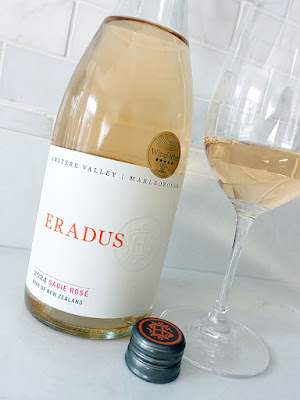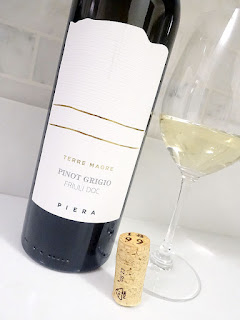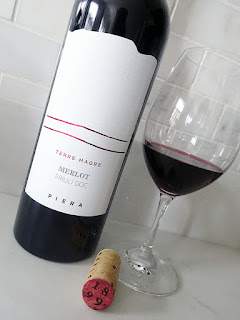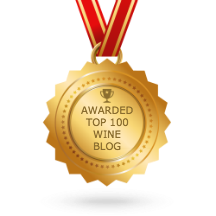red wine review is a lovely Pinot Noir from the Awatere Valley in Marlborough that arrived at the LCBO in last month's LCBO VINTAGES New Release Collection.
This wine is produced by Eradus Wines, a family-owned winery that was established by Har and Sophie Eradus in the 1990s on an extraordinary footprint of land at the edge of the Awatere river. The couple had emigrated from Holland in 1982 and grew flowers in Auckland before embarking on this semi-retirement project to grow grapes in the Awatere Valley - a dryland that was sheep country at the time with only a few pioneering winegrowers.
The Eradus couple's imagination was captured by this sliver of land that was nestled between a higher terrace and the glacial river below, with its guarding boundary of gnarled old macrocarpa cypress trees. Their connection to this land seemed fated when Sophie cleared a shed on the property and found an old potbelly door with an embossed logo that entwined their initials - "H", "S" and "E" - which inspired the Eradus wine label.
From the beginning, Har and Sophie desired to have the unique and wild terroir of the Awatere Valley speak through their vines. This journey began with their first vintage - a 2002 Sauvignon Blanc - and heralded a future of extraordinary wines that reflect the essence of the Awatere Valley.
Today, Eradus Wines is run by their son, Michiel, and his Kiwi wife, Hanna, as they took over the family business in 2004. Together, the second generation of the Eradus family is committed to celebrating the unique terroir of this place, with a philosophy based upon bending to nature and letting the Awatere Valley imprint itself upon every Eradus wine. Knowing that good fortune led the family to this remarkable piece of land in a valley that is now globally acclaimed for its wines, the Eradus family's role has been to take this good luck and build it into vines and wines that pay homage to the Awatere Valley.
Crafted with 100% Pinot Noir from 23-year-old vines, the grapes for this wine were grown on a slender terrace with alluvial (river stone) soil at the edge of the Awatere River. This area has a unique microclimate and soil structure that is influenced by a fault line, river, and the power of the nearby Pacific Ocean. The land is stony, dry, windy and cool - elements that create lively wines of elegance and minerality. At Eradus, they let the untameable terroir of the Awatere Valley express itself through their vines, grapes, and ultimately - the wines. Bringing together "new world" fruit and "old world" elegance and minerality, this Pinot was aged for 10 months in barrel and released in June 2024.
The growing season on the South Island of New Zealand in 2023 felt wet because it rained quite evenly from January to April, although total rainfall was slightly lower than average. Furthermore, variable and protracted flowering of early ripening varieties such as Pinot Noir resulted in below average yields due to poor fruit set. This also led to loose bunches, which meant less disease vulnerability, and was an important factor in the success of the vintage. Cold nights held botrytis at bay and maintained acidity. From a La Niña year, the 2023 vintage is considered to be a resounding success, ranking among the top five vintages of all time. Let's see how this 2023 Pinot Noir from Awatere Valley is tasting tonight...
Screw cap. Lifted and open, this has an appealing, medium-high intensity nose featuring aromas of sour cherry, strawberry, savoury mushroom, and earthy beetroot accented with spices and bramble, plus reductive whiffs of oak and dried herbs. The light-to-mid-weighted palate is dry with raspberry, cran-cherry, sour cherry, dried herbs, earthy beetroot, and mushroom flavours, plus touches of stony minerals. Acids are juicy, fresh, and succulent, while the light tannins are gently grainy textured, with gentle grip and good structure on the back palate. Juicy and mouthwatering on the long finish with savoury, dried herb, sour cherry, and earthy beetroot notes. Recommended buy! Score: 90 pts
A couple of other wines by Eradus are available at the LCBO, while the full range can be ordered through their Agent - Kolonaki Fine Wines & Spirits.
This wine is produced by Eradus Wines, a family-owned winery that was established by Har and Sophie Eradus in the 1990s on an extraordinary footprint of land at the edge of the Awatere river. The couple had emigrated from Holland in 1982 and grew flowers in Auckland before embarking on this semi-retirement project to grow grapes in the Awatere Valley - a dryland that was sheep country at the time with only a few pioneering winegrowers.
The Eradus couple's imagination was captured by this sliver of land that was nestled between a higher terrace and the glacial river below, with its guarding boundary of gnarled old macrocarpa cypress trees. Their connection to this land seemed fated when Sophie cleared a shed on the property and found an old potbelly door with an embossed logo that entwined their initials - "H", "S" and "E" - which inspired the Eradus wine label.
From the beginning, Har and Sophie desired to have the unique and wild terroir of the Awatere Valley speak through their vines. This journey began with their first vintage - a 2002 Sauvignon Blanc - and heralded a future of extraordinary wines that reflect the essence of the Awatere Valley.
Today, Eradus Wines is run by their son, Michiel, and his Kiwi wife, Hanna, as they took over the family business in 2004. Together, the second generation of the Eradus family is committed to celebrating the unique terroir of this place, with a philosophy based upon bending to nature and letting the Awatere Valley imprint itself upon every Eradus wine. Knowing that good fortune led the family to this remarkable piece of land in a valley that is now globally acclaimed for its wines, the Eradus family's role has been to take this good luck and build it into vines and wines that pay homage to the Awatere Valley.
Crafted with 100% Pinot Noir from 23-year-old vines, the grapes for this wine were grown on a slender terrace with alluvial (river stone) soil at the edge of the Awatere River. This area has a unique microclimate and soil structure that is influenced by a fault line, river, and the power of the nearby Pacific Ocean. The land is stony, dry, windy and cool - elements that create lively wines of elegance and minerality. At Eradus, they let the untameable terroir of the Awatere Valley express itself through their vines, grapes, and ultimately - the wines. Bringing together "new world" fruit and "old world" elegance and minerality, this Pinot was aged for 10 months in barrel and released in June 2024.
The growing season on the South Island of New Zealand in 2023 felt wet because it rained quite evenly from January to April, although total rainfall was slightly lower than average. Furthermore, variable and protracted flowering of early ripening varieties such as Pinot Noir resulted in below average yields due to poor fruit set. This also led to loose bunches, which meant less disease vulnerability, and was an important factor in the success of the vintage. Cold nights held botrytis at bay and maintained acidity. From a La Niña year, the 2023 vintage is considered to be a resounding success, ranking among the top five vintages of all time. Let's see how this 2023 Pinot Noir from Awatere Valley is tasting tonight...
Tasting Note:
ERADUS PINOT NOIR 2023 - Awatere Valley, Marlborough, South Island, New Zealand (#41809) (XD) - $24.95Screw cap. Lifted and open, this has an appealing, medium-high intensity nose featuring aromas of sour cherry, strawberry, savoury mushroom, and earthy beetroot accented with spices and bramble, plus reductive whiffs of oak and dried herbs. The light-to-mid-weighted palate is dry with raspberry, cran-cherry, sour cherry, dried herbs, earthy beetroot, and mushroom flavours, plus touches of stony minerals. Acids are juicy, fresh, and succulent, while the light tannins are gently grainy textured, with gentle grip and good structure on the back palate. Juicy and mouthwatering on the long finish with savoury, dried herb, sour cherry, and earthy beetroot notes. Recommended buy! Score: 90 pts
A couple of other wines by Eradus are available at the LCBO, while the full range can be ordered through their Agent - Kolonaki Fine Wines & Spirits.






























